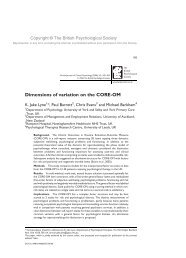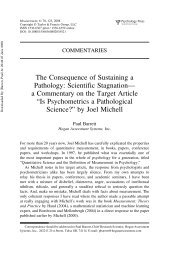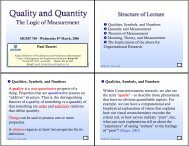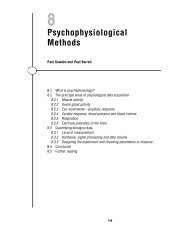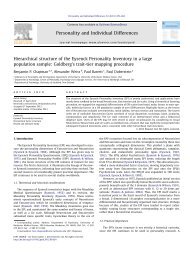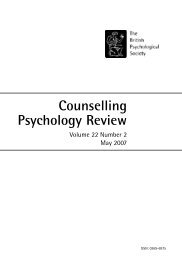What If There Were No Psychometrics?: Constructs ... - Paul Barrett
What If There Were No Psychometrics?: Constructs ... - Paul Barrett
What If There Were No Psychometrics?: Constructs ... - Paul Barrett
You also want an ePaper? Increase the reach of your titles
YUMPU automatically turns print PDFs into web optimized ePapers that Google loves.
136 BARRETT<br />
lating PR g with CR6. In terms of McGrath’s (2005/this issue)<br />
expositionofconceptuallycomplexvariables,onemightview<br />
theWittmann(2003)frameworkasonepotentialwayofexplicating<br />
variable complexity and the putative relations between<br />
constituent components of a complex variable and other variables.<br />
In short, the reason why some predictions fail when using<br />
complex (multiconstituent) variables is not just that the<br />
complexityofaglobalvariablemaybedisguisingconstituents<br />
that share little in common with the overall global measure but<br />
that the criterion itself has been so badly construed such that<br />
the symmetry between predictor and criterion is not what it<br />
shouldbe.However,Brunswik(1952)symmetryisnotapanacea<br />
for a construct whose components are poorly constructed<br />
and for one in which no coherent theory exists about the nature<br />
and constituent properties of that construct. This point is<br />
brought home clearly by McGrath in his discussion of Revised<br />
NEO Personality Inventory (NEO–PI–R; Costa & McCrae,<br />
1992) facet scales, especially the feelings subscale to which he<br />
refers explicitly.<br />
CROSS-MODAL CONSTRUCT CONSISTENCY<br />
With respect to McGrath’s (2005/this issue) comments on<br />
cross-modal consistency of constructs, especially with regard<br />
to “the common assumption that a self-report measure<br />
can sufficiently represent a complex construct such as anxiety<br />
[italics added]” (p. 115), Weinberger, Schwartz, and<br />
Davidson’s (1979) work on the cognitive processes involved<br />
in anxiety and M. W. Eysenck’s (1997a, 1997b) subsequent<br />
extension and theory of anxiety demonstrated the fallacy that<br />
a self-report measure of anxiety is an accurate magnitude of a<br />
single unidimensional variable. The expectations and theory<br />
of H. J. Eysenck (1967) that magnitudes of self-report anxiety<br />
were caused (or depended on) functioning of the limbic<br />
system or Gray’s (1982) theory that implicated septohippocampal<br />
system functioning have been shown to be<br />
largely unfounded in a review of the evidence by Fahrenberg<br />
(1987, 1992). The problem for researchers who take a low<br />
score on a self-report anxiety measure as indicative of “low<br />
trait anxiety” is that this group are in fact heterogenous given<br />
the meaning of an anxiety latent variable is defined by the<br />
correspondence of self-report and physiological response indexes.<br />
Weinberger et al. (1979), in an experiment designed to<br />
show this disparity of construct criteria, obtained measures<br />
of trait anxiety and social desirability from a group of participants<br />
in an experiment designed to test their theory that high<br />
scores on social desirability confound the self-report measure<br />
of anxiety such that low scorers on an anxiety scale and a<br />
social desirability scale might genuinely possess low levels<br />
of trait anxiety, or, if they obtain a high score on social desirability<br />
but a low score on anxiety, they are in fact<br />
“repressors.” That is, their physiological response will be<br />
more similar to a high-anxiety individual, yet their cognitive<br />
repression of their own elevated trait anxiety level causes<br />
them to be assessed as “low-anxiety” individuals on any<br />
questionnaire measure. To test this theory-based hypothesis,<br />
the participants were exposed to a moderately stressful situation.<br />
The repressors responded physiologically much more<br />
than the truly low-anxious individuals. Of great significance<br />
is that the repressors responded physiologically at magnitudes<br />
beyond individuals who possessed high self-report trait<br />
levels of anxiety. This work, as M. W. Eysenck (1997a) indicated,<br />
has been replicated by independent investigators. <strong>No</strong>t<br />
only does this finding have enormous implications for the acquisition<br />
of evidence for the Gray and H. J. Eysenck models<br />
of anxiety (and explains Fahrenberg’s [1992] disappointing<br />
conclusions in his review of the evidence), but with respect to<br />
McGrath’s point concerning the complexity of psychological<br />
constructs, it reinforces his arguments considerably. It is also<br />
interesting to note that construction of a latent variable of<br />
anxiety using item response theory (IRT; Ferrando, 2003)<br />
would be as ineffective as classical test theory given the same<br />
self-report data. I say more about this following.<br />
CONSTRUCT VALIDITY AND MEASUREMENT<br />
Under the heading of “Multi-Item Scales as Representations,”<br />
McGrath (2005/this issue) states “The bias toward<br />
criterion-related validity as an evidentiary basis for construct<br />
validity leads test users to assume the larger correlations<br />
associated with multi-item scales means that they are<br />
better scales overall [italics added]” (p. 117). McGrath goes<br />
on to note that what makes a good predictor might have no association<br />
with what is necessarily a good representation of<br />
the construct, and therein lies the heart of the issue—How<br />
can we detect if our conceptualization of a construct, embodied<br />
in a measurement process, is valid? This question and its<br />
component parts are similar to the question posed by<br />
Borsboom, Mellenbergh, and van Heerden (2004) in an article<br />
devoted to the concept of validity. Borsboom et al. proposed<br />
a simple definition of validity:<br />
<strong>If</strong> something does not exist then one cannot measure it. <strong>If</strong> it<br />
exists but does not causally produce variations in the outcomes<br />
of the measurement procedure, then one is either measuring<br />
nothing at all or something different altogether. Thus a<br />
test is valid for measuring an attribute if and only if a) the attribute<br />
exists, and b) variations in the attribute causally produce<br />
variations in the outcomes of the measurement procedure.<br />
(p. 1061)<br />
Of course, hidden in this disarmingly simple definition of<br />
validity, in fact, “construct validity,” is the phrase “causally<br />
produce variations.” <strong>What</strong> this requires is what McGrath<br />
(2005/this issue) also asks for some deep consideration of<br />
what the properties of an attribute might be so that an investigator<br />
might recognize its causal effects when using a test that<br />
purports to measure magnitudes of it. A critical point though,



